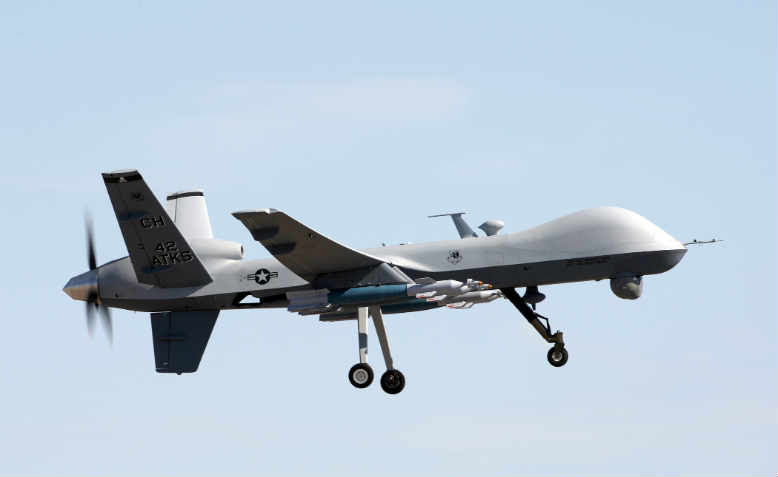 General Atomics MQ-9 Reaper drone in training, 2008. Photo: Wikimedia/Paul Ridgeway
General Atomics MQ-9 Reaper drone in training, 2008. Photo: Wikimedia/Paul Ridgeway
Don’t believe the hype, the Obama administration’s war record is bloody and shameful, argues Lindsey German
Barack Obama entered office eight years ago and was rapidly awarded the Nobel Peace Prize.
He pleased left opinion and infuriated the right this week as he left office by granting a presidential pardon to whistleblower Chelsea Manning — sentenced to 35 years in prison for telling the truth about the United States’s dirty war secrets and the rotten dictators it does deals with.
So that peace prize was justified? Well not exactly, in fact not at all.
Obama’s record over eight years shows a president who was certainly more risk averse and more isolationist than many of his post-second world war predecessors, but who did his duty as head of the world’s remaining superpower, the most militarised country on earth, and the one whose record of military intervention is second to none.
In his last year of office alone, according to US peace activist Medea Benjamin, “the Obama administration dropped at least 26,171 bombs.
This means that every day last year, the US military blasted combatants or civilians overseas with 72 bombs; that’s three bombs every hour, 24 hours a day.”
These bombs fell on in Syria and Libya, but also in countries most people would not regard the US as being at war with — Somalia, Pakistan, Yemen — as well as the long-suffering Afghanistan and Libya. So much for peace.
Terrible
Obama’s big promise was that he would end US intervention in Iraq. The troops were withdrawn but Obama maintained special advisers and trainers, backing a sectarian government in Iraq. The fostering of sectarian tensions which had developed under US and British occupation continued, helping to feed the growth of Isis.
Now the US military is back in Iraq, embroiled in a bloody battle in Mosul.
In Afghanistan, the troops never left. Despite promises to the contrary, Obama continued to keep them there and continued to bomb with often terrible consequences, such as when a hospital in Kunduz was targeted by US planes.
The bombing of Libya in 2011 was engineered as regime change, despite its ostensible purpose of being a humanitarian intervention to save the people of Benghazi. Around 30,000 died in that bombing. The civil war that started then still rages six years on with many thousands more dead and displaced. The gloating of Hillary Clinton at the death of Gadaffi marked a low point of his administration.
Overthrown
One of the great myths perpetrated by rightwingers is that Obama did not intervene in Syria. His secretary of state Clinton was among the most hawkish, refusing to engage in any talks which involved President Bashar al-Assad, most crucially in 2012 when the US believed that he was about to be overthrown.
The US has covertly intervened in Syria using special forces and by giving support to opposition groups. Obama wanted to launch military intervention against Assad in the summer of 2013, but was only prevented from doing so by the vote in the British Parliament against war.
The closest allies of the US in the Middle East, such as Saudi Arabia, Qatar and — until recently — Turkey have been heavily involved in supporting Isis and other groups.
A major reason for Obama’s more risk-averse approach to direct intervention was his understanding of just how deeply unpopular the wars in Iraq and, to some extent, Afghanistan were. Hence less use of US troops on the ground and a much bigger use of special hit squads and drone warfare. This is virtually cost free for US lives but deadly for civilians in the countries bombed.
Increased surveillance, the use of torture and the continuing existence of Guantanamo Bay have all marked the Obama presidency. They are all intact to be taken over and further misused by Donald Trump.
Clashes
Another legacy is the widespread demonisation of Vladimir Putin’s Russia, and the consequent build-up of Nato troops on Russia’s border. Again, encouraged by Clinton, this conflict is a major threat to world peace today. When Russia is blamed for everything from intervening in the US election (a bit rich coming from the US which intervenes in so many elections) to leaking the ending of the BBC’s Sherlock series, we should be aware of the prospects for further clashes.
Obama’s pivot to the Pacific has targeted China as a major military and economic rival. While Obama has been unable to develop it fully because the US has been bogged down in the Middle East, Trump has already made clear his lines of division with China, and this will be a major and dangerous feature of his foreign policy.
The migrants desperate to get from central and Latin America across the border to the US are themselves often victims of US trade and economic policies in their home countries.
Obama has backed these policies and the successive right-wing assaults on democracy from Brazil to Honduras.
Trump will continue these policies with a vengeance. He also claims that he will deal with terrorism, although his Islamophobia and racism are likely to help fuel it.
The truth is that terrorism worldwide has grown exponentially during the period of the war on terror from 2001 and Obama’s policies — drone warfare, rendition, deportation and continued occupation — have done much to create the conditions where it thrives.
Perhaps the worst picture of Obama during these years is the one where he is shown, along with Clinton and the military, watching the real-time assassination of Osama bin Laden.
We were told then it would mark a turning point in the war on terror. The opposite has proved true. Most of us fear for what Trump can and might do, and detest his racist, sexist braggadocio. But we should remember that Obama could have done so much more — and didn’t.

